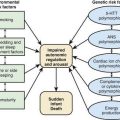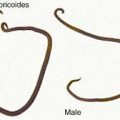Chapter 571 Cushing Syndrome
Cushing syndrome is the result of abnormally high blood levels of cortisol or other glucocorticoids. This can be iatrogenic or the result of endogenous cortisol secretion, due either to an adrenal tumor or to hypersecretion of corticotropin (adrenocorticotropic hormone [ACTH]) by the pituitary (Cushing disease) or by a tumor (Table 571-1).
Table 571-1 ETIOLOGIC CLASSIFICATION OF ADRENOCORTICAL HYPERFUNCTION
EXCESS ANDROGEN
EXCESS CORTISOL (CUSHING SYNDROME)
EXCESS MINERALOCORTICOID
EXCESS ESTROGEN
Tumor
Etiology
Endogenous Cushing syndrome is most often caused in infants by a functioning adrenocortical tumor (Chapter 573). Patients with these tumors often exhibit signs of hypercortisolism along with signs of hypersecretion of other steroids such as androgens, estrogens, and aldosterone.
ACTH-dependent Cushing syndrome may also result from ectopic production of ACTH, although this is uncommon in children. Ectopic ACTH secretion in children has been associated with islet cell carcinoma of the pancreas, neuroblastoma or ganglioneuroblastoma, hemangiopericytoma, Wilms tumor, and thymic carcinoid. Hypertension is more common in the ectopic ACTH syndrome than in other forms of Cushing syndrome, because very high cortisol levels may overwhelm 11β-hydroxysteroid dehydrogenase in the kidney (Chapter 568) and thus have an enhanced mineralocorticoid (salt-retaining) effect.
Several syndromes are associated with the development of multiple autonomously hyperfunctioning nodules of adrenocortical tissue, rather than single adenomas or carcinomas (which are discussed in Chapter 573). Primary pigmented nodular adrenocortical disease (PPNAD) is a distinctive form of ACTH-independent Cushing syndrome. It may occur as an isolated event or, more commonly, as a familial disorder with other manifestations. The adrenal glands are small and have characteristic multiple, small (<4 mm in diameter), pigmented (black) nodules containing large cells with cytoplasm and lipofuscin; there is cortical atrophy between the nodules. This adrenal disorder occurs as a component of Carney complex, an autosomal dominant disorder also consisting of centrofacial lentigines and blue nevi; cardiac and cutaneous myxomas; pituitary, thyroid, and testicular tumors; and pigmented melanotic schwannomas. Carney complex is inherited in an autosomal dominant manner, although sporadic cases occur. Genetic loci for Carney complex have been mapped to the gene for the type 1α regulatory subunit of protein kinase A (PRKAR1A) on chromosome 17q22-24 and less frequently to chromosome 2p16. Patients with with Carney complex and PRKAR1A mutations generally develop PPNAD as adults, and those with the disorder mapping to chromosome 2 (and most sporadic cases) develop PPNAD less frequently and later. Conversely, children presenting with PPNAD as an isolated finding rarely have mutations in PRKAR1A, or subsequently develop other manifestations of Carney complex. Some patients with isolated PPNAD have mutations in the PDE8B or PDE11A genes encoding different phosphodiesterase isozymes.
Additionally, adrenocortical lesions including diffuse hyperplasia, nodular hyperplasia, adenoma, and rarely carcinoma may occur as part of the multiple endocrine neoplasia type 1 syndrome, an autosomal dominant disorder, in which there is homozygous inactivation of the menin (MEN1) tumor suppressor gene on chromosome 11q13 (Chapter 567).
Treatment
Management of patients undergoing adrenalectomy requires adequate preoperative and postoperative replacement therapy with a corticosteroid. Tumors that produce corticosteroids usually lead to atrophy of the normal adrenal tissue, and replacement with cortisol (10 mg/m2/24 hr in 3 divided doses after the immediate postoperative period) is required until there is recovery of the hypothalamic-pituitary-adrenal axis. Postoperative complications may include sepsis, pancreatitis, thrombosis, poor wound healing, and sudden collapse, particularly in infants with Cushing syndrome. Substantial catch-up growth, pubertal progress, and increased bone density occur, but bone density remains abnormal and adult height is often compromised. The management of adrenocortical tumors is discussed in Chapter 573.
Batista D, Gennari M, Riar J, et al. An assessment of petrosal sinus sampling for localization of pituitary microadenomas in children with Cushing disease. J Clin Endocrinol Metab. 2006;91:221-224.
Batista DL, Riar J, Keil M, et al. Diagnostic tests for children who are referred for the investigation of Cushing syndrome. Pediatrics. 2007;120:e575-e586.
Bertherat J, Horvath A, Groussin L, et al. Mutations in regulatory subunit type 1A of cyclic adenosine 5’-monophosphate-dependent protein kinase (PRKAR1A): phenotype analysis in 353 patients and 80 different genotypes. J Clin Endocrinol Metab. 2009;94:2085-2091.
Gillis D, Rosler A, Hannon TS, et al. Prolonged remission of severe Cushing syndrome without adrenalectomy in an infant with McCune-Albright syndrome. J Pediatr. 2008;152:882-884.
Horvath A, Boikos S, Giatzakis C, et al. A genome-wide scan identifies mutations in the gene encoding phosphodiesterase 11A4 (PDE11A) in individuals with adrenocortical hyperplasia. Nat Genet. 2006;38:794-800.
Keil MF, Stratakis CA. Pituitary tumors in childhood: update of diagnosis, treatment and molecular genetics. Expert Rev Neurother. 2008;8:563-574.
Nieman LK, Biller BM, Findling JW, et al. The diagnosis of Cushing’s syndrome: an Endocrine Society Clinical Practice Guideline. J Clin Endocrinol Metab. 2008;93:1526-1540.
Powell AC, Stratakis CA, Patronas NJ, et al. Operative management of Cushing syndrome secondary to micronodular adrenal hyperplasia. Surgery. 2008;143:750-758.
Savage MO, Chan LF, Grossman AB, et al. Work-up and management of paediatric Cushing’s syndrome. Curr Opin Endocrinol Diabetes Obes. 2008;15:346-351.







